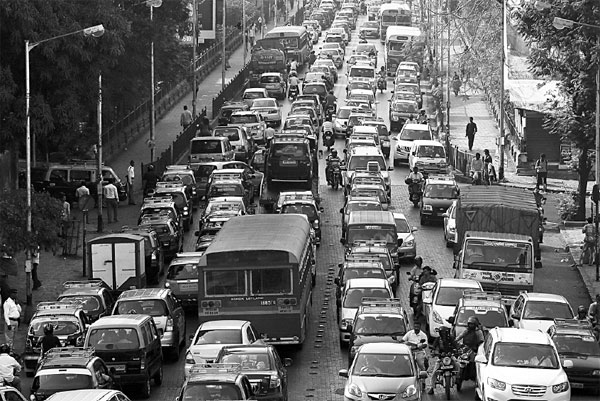Modi vow to unclog nation faces grimmer reality
|
A traffic jam in Mumbai, India. Indian Prime Minister Narendra Modi's vision of bullet trains and jam-free roads could be hampered by a failure to achieve infrastructure spending goals. Rajanish Kakade / AP |
Indian Prime Minister Narendra Modi's vision of bullet trains and jam-free roads connecting gleaming cities lit by reliable power faces an obstacle: the difficulty of achieving infrastructure spending goals.
Modi in July said he'd boost outlays on projects such as highways and ports 21 percent to 5.75 trillion rupees ($93 billion) in the year through March 2015. In the nine months ending December, he'd spent 3.5 trillion rupees - little changed on the same period in the prior fiscal year.
UBS Group AG sees Modi increasing capital spending 35 percent in India's budget on Saturday, but the question is how much of the plan gets implemented by a byzantine bureaucracy. The answer will determine whether Modi can make good on his vow to energize growth and help shape the outlook for construction companies such as Larsen & Toubro Ltd and Lanco Infratech Ltd that face falling profits or losses.
"They might be doing quite a few good things on a long-term perspective basis, in terms of changing the overall atmosphere, but still at the grassroot level, hardly anything has been delivered," said Kishor Kumar Mohanty, managing director of Gammon Infrastructure Projects Ltd. While Modi has curbed graft, bureaucrats may be more sluggish to drive public works as they aren't gaining financially, he said.
Such views suggest the government's push to speed up environmental and other approvals for stalled major projects has yet to fully filter into the economy. At the same time, rising bad debts are curbing private companies' scope for investment.
Capital expenditure plans by state-run and private businesses will drop 4 percent in the year starting April 1, a survey by Standard & Poor's domestic unit Crisil Ltd shows. Private companies alone plan to cut such outlays 11 percent.
"The message coming through is crystal clear: as things stand, there's only one way to kick-start the all-important investment cycle, and that's through public investment," Crisil President for Ratings Raman Uberoi said. "The onus is on the government to do the initial heavy lifting."
Profit at Larsen & Toubro, India's largest engineering company, fell 15 percent to 10.6 billion rupees in the three months ended December. Lanco Infratech lost 6.4 billion rupees. Gammon Infrastructure posted a profit of 59.8 million rupees.
The $12 billion steel complex proposed by Posco, South Korea's biggest steelmaker, for Odisha state is an example of the task companies face to get permits. The project has been awaiting approvals for about a decade. Posco is now planning to shut its engineering and construction unit in India and is considering cutting 13 jobs at the site of the proposed factory.
India's investment as percentage of gross domestic product dropped to 32 percent in 2014 from 38 percent in 2007, falling below Indonesia at 33 percent and widening the gap with China at 48 percent, according to International Monetary Fund data.
The premier has also pledged to fight graft.
In a sting operation last week, police arrested five people and recovered stacks of stolen documents from the coal, power and oil ministries. The probe widened over the weekend, with seven people detained. Among those held are officials from Reliance Industries, Essar Oil Ltd, Cairn India Ltd, Jubilant Energy NV and Reliance Group, according to police in New Delhi.



















